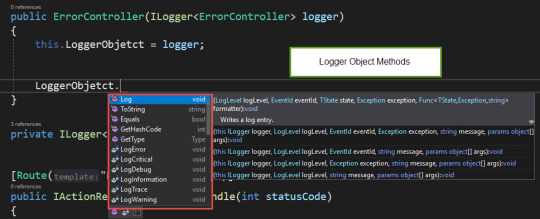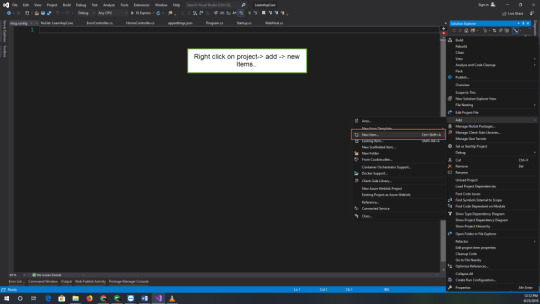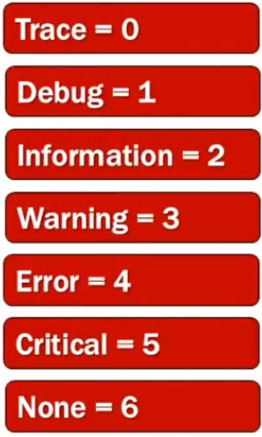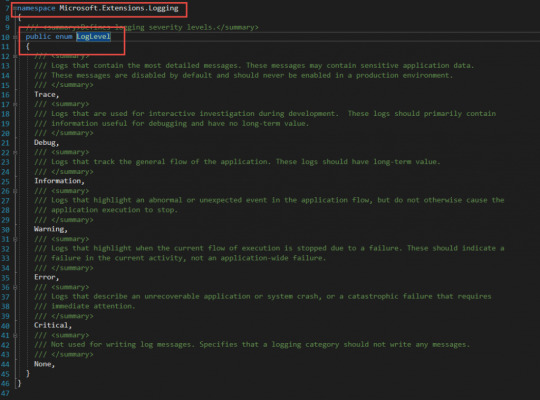#Serilog .NET logging
Explore tagged Tumblr posts
Text
Built-in Logging with Serilog: How EasyLaunchpad Keeps Debugging Clean and Insightful

Debugging shouldn’t be a scavenger hunt.
When things break in production or behave unexpectedly in development, you don’t have time to dig through vague error messages or guess what went wrong. That’s why logging is one of the most critical — but often neglected — parts of building robust applications.
With EasyLaunchpad, logging is not an afterthought.
We’ve integrated Serilog, a powerful and structured logging framework for .NET, directly into the boilerplate so developers can monitor, debug, and optimize their apps from day one.
In this post, we’ll explain how Serilog is implemented inside EasyLaunchpad, why it’s a developer favorite, and how it helps you launch smarter and maintain easier.
🧠 Why Logging Matters (Especially in Startups)
Whether you’re launching a SaaS MVP or maintaining a production application, logs are your eyes and ears:
Track user behavior
Monitor background job status
Catch and analyze errors
Identify bottlenecks or API failures
Verify security rules and access patterns
With traditional boilerplates, you often need to configure and wire this up yourself. But EasyLaunchpad comes preloaded with structured, scalable logging using Serilog, so you’re ready to go from the first line of code.
🔧 What Is Serilog?
Serilog is one of the most popular logging libraries for .NET Core. Unlike basic logging tools that write unstructured plain-text logs, Serilog generates structured logs — which are easier to search, filter, and analyze in any environment.
It supports:
JSON log output
File, Console, or external sinks (like Seq, Elasticsearch, Datadog)
Custom formats and enrichers
Log levels: Information, Warning, Error, Fatal, and more
Serilog is lightweight, flexible, and production-proven — ideal for modern web apps like those built with EasyLaunchpad.
🚀 How Serilog Is Integrated in EasyLaunchpad

When you start your EasyLaunchpad-based project, Serilog is already:
Installed via NuGet
Configured via appsettings.json
Injected into the middleware pipeline
Wired into all key services (auth, jobs, payments, etc.)
🔁 Configuration Example (appsettings.json):
“Serilog”: {
“MinimumLevel”: {
“Default”: “Information”,
“Override”: {
“Microsoft”: “Warning”,
“System”: “Warning”
}
},
“WriteTo”: [
{ “Name”: “Console” },
{
“Name”: “File”,
“Args”: {
“path”: “Logs/log-.txt”,
“rollingInterval”: “Day”
}
}
}
}
This setup gives you daily rotating log files, plus real-time console logs for development mode.
🛠 How It Helps Developers
✅ 1. Real-Time Debugging
During development, logs are streamed to the console. You’ll see:
Request details
Controller actions triggered
Background job execution
Custom messages from your services
This means you can debug without hitting breakpoints or printing Console.WriteLine().
✅ 2. Structured Production Logs
In production, logs are saved to disk in a structured format. You can:
Tail them from the server
Upload them to a logging platform (Seq, Datadog, ELK stack)
Automatically parse fields like timestamp, level, message, exception, etc.
This gives predictable, machine-readable logging — critical for scalable monitoring.
✅ 3. Easy Integration with Background Jobs
EasyLaunchpad uses Hangfire for background job scheduling. Serilog is integrated into:
Job execution logging
Retry and failure logs
Email queue status
Error capturing
No more “silent fails” in background processes — every action is traceable.
✅ 4. Enhanced API Logging (Optional Extension)
You can easily extend the logging to:
Log request/response for APIs
Add correlation IDs
Track user activity (e.g., login attempts, failed validations)
The modular architecture allows you to inject loggers into any service or controller via constructor injection.
🔍 Sample Log Output
Here’s a typical log entry generated by Serilog in EasyLaunchpad:
{
“Timestamp”: “2024–07–10T08:33:21.123Z”,
“Level”: “Information”,
“Message”: “User {UserId} logged in successfully.”,
“UserId”: “5dc95f1f-2cc2–4f8a-ae1b-1d29f2aa387a”
}
This is not just human-readable — it’s machine-queryable.
You can filter logs by UserId, Level, or Timestamp using modern logging dashboards or scripts.
🧱 A Developer-Friendly Logging Foundation
Unlike minimal templates, where you have to integrate logging yourself, EasyLaunchpad is:
Ready-to-use from first launch
Customizable for your own needs
Extendable with any Serilog sink (e.g., database, cloud services, Elasticsearch)
This means you spend less time configuring and more time building and scaling.
🧩 Built-In + Extendable
You can add additional log sinks in minutes:
Log.Logger = new LoggerConfiguration()
.WriteTo.Console()
.WriteTo.File(“Logs/log.txt”)
.WriteTo.Seq(“http://localhost:5341")
.CreateLogger();
Want to log in to:
Azure App Insights?
AWS CloudWatch?
A custom microservice?
Serilog makes it possible, and EasyLaunchpad makes it easy to start.
💼 Real-World Scenarios
Here are some real ways logging helps EasyLaunchpad-based apps:
Use Case and the Benefit
Login attempts — Audit user activity and failed attempts
Payment errors- Track Stripe/Paddle API errors
Email queue- Debug failed or delayed emails
Role assignment- Log admin actions for compliance
Cron jobs- Monitor background jobs in real-time
🧠 Final Thoughts
You can’t fix what you can’t see.
Whether you’re launching an MVP or running a growing SaaS platform, structured logging gives you visibility, traceability, and peace of mind.
EasyLaunchpad integrates Serilog from day one — so you’re never flying blind. You get a clean, scalable logging system with zero setup required.
No more guesswork. Just clarity.
👉 Start building with confidence. Check out EasyLaunchpad at https://easylaunchpad.com and see how production-ready logging fits into your stack.
#Serilog .NET logging#structured logs .NET Core#developer-friendly logging in boilerplate#.net development#saas starter kit#saas development company#app development#.net boilerplate
1 note
·
View note
Text
🚀 How EasyLaunchpad Helps You Launch a SaaS App in Days, Not Months

Bringing a SaaS product to life is exciting — but let’s be honest, the setup phase is often a painful time sink. You start a new project with energy and vision, only to get bogged down in the same tasks: authentication, payments, email systems, dashboards, background jobs, and system logging.
Wouldn’t it be smarter to start with all of that already done?
That’s exactly what EasyLaunchpad offers.
Built on top of the powerful .NET Core 8.0 framework, EasyLaunchpad is a production-ready boilerplate designed to let developers and SaaS builders launch their apps in days, not months.
💡 The Problem: Rebuilding the Same Stuff Over and Over
Every developer has faced this dilemma:
Rebuilding user authentication and Google login
Designing and coding the admin panel from scratch
Setting up email systems and background jobs
Integrating Stripe or Paddle for payments
Creating a scalable architecture without cutting corners
Even before you get to your actual product logic, you’ve spent days or weeks rebuilding boilerplate components. That’s precious time you can’t get back — and it delays your path to market.
EasyLaunchpad solves this by providing a ready-to-launch foundation so you can focus on building what’s unique to your business.
🔧 Prebuilt Features That Save You Time
Here’s a breakdown of what’s already included and wired into the EasyLaunchpad boilerplate:
✅ Authentication (with Google OAuth & Captcha)
Secure login and registration flow out of the box, with:
Email-password authentication
Google OAuth login
CAPTCHA validation to protect against bots
No need to worry about setting up Identity or external login providers — this is all included.
✅ Admin Dashboard Built with Tailwind CSS + DaisyUI
A sleek, responsive admin panel you don’t have to design yourself. Built using Razor views with TailwindCSS and DaisyUI, it includes:
User management (CRUD, activation, password reset)
Role management
Email configuration
System settings
Packages & plan management
It’s clean, modern, and instantly usable.
✅ Email System with DotLiquid Templating
Forget about wiring up email services manually. EasyLaunchpad includes:
SMTP email dispatch
Prebuilt templates using DotLiquid (a Shopify-style syntax)
Customizable content for account activation, password reset, etc.
✅ Queued Emails & Background Jobs with Hangfire
Your app needs to work even when users aren’t watching. That’s why EasyLaunchpad comes with:
Hangfire integration for scheduled and background jobs
Retry logic for email dispatches
Job dashboard via admin or Hangfire’s built-in UI
Perfect for automated tasks, periodic jobs, or handling webhooks.
✅ Stripe & Paddle Payment Integration
Monetization-ready. Whether you’re selling licenses, subscription plans, or one-time services:
Stripe and Paddle payment modules are already integrated
Admin interface for managing packages
Ready-to-connect with your website or external payment flows
✅ Package Management via Admin Panel
Whether you offer basic, pro, or enterprise plans — EasyLaunchpad gives you:
#CRUD interface to define your packages
Connect them with #Stripe/#Paddle
Offer them via your front-end site or API
No need to build a billing system from scratch.
✅ Serilog Logging for Debugging & Monitoring
Built-in structured logging with Serilog makes it easy to:
Track system events
Log user activity
Debug errors in production
Logs are clean, structured, and production-ready.
✅ Clean Modular Codebase & Plug-and-Play Modules
EasyLaunchpad uses:
Clean architecture (Controllers → Services → Repositories)
Autofac for dependency injection
Modular separation between Auth, Email, Payments, and Admin logic
You can plug in your business logic without breaking what’s already working.
🏗️ Built for Speed — But Also for Scale
EasyLaunchpad isn’t just about launching fast. It’s built on scalable tech, so you can grow with confidence.
✅ .NET Core 8.0
Blazing-fast, secure, and LTS-supported.
✅ Tailwind CSS + DaisyUI
Modern UI stack without bloat — fully customizable and responsive.
✅ Entity Framework Core
Use SQL Server or switch to your own #DB provider. EF Core gives you flexibility and productivity.
✅ Environment-Based Configs
Configure settings via appsettings.json for development, staging, or production — all supported out of the box.
🧩 Who Is It For?
👨💻 Indie Hackers
Stop wasting time on boilerplate and get to your #MVP faster.
🏢 Small Teams
Standardize your project structure and work collaboratively using a shared, modular codebase.
🚀 Startup Founders
Go to market faster with all essentials already covered — build only what makes your app different.
💼 What Can You Build With It?
EasyLaunchpad is perfect for:
SaaS products (subscription-based or usage-based)
Admin dashboards
AI-powered tools
Developer platforms
Internal portals
Paid tools and membership-based services
If it needs login, admin, payments, and email — it’s a fit.
🧠 Final Thoughts
#Launching a #SaaS product is hard enough. Don’t let the boilerplate slow you down.
With EasyLaunchpad, you skip the foundational headaches and get right to building what matters. Whether you’re a solo developer or a small team, you get a clean, powerful codebase that’s ready for production — in days, not months.
👉 Start building smarter. Visit easylaunchpad.com and get your boilerplate license today.
#easylaunchpad #bolierplate #.net
1 note
·
View note
Text
Essential Tools for .NET Developers

.NET development requires a robust set of tools to enhance productivity, streamline development, and ensure high-quality applications.
Whether you’re building web applications, desktop software, or cloud-based solutions, having the right tools can make a significant difference. Here’s a list of essential tools for .NET developers:
1. IDEs and Code Editors
Visual Studio — The most powerful and widely used IDE for .NET development, offering features like IntelliSense, debugging, and seamless integration with Azure.
Visual Studio Code (VS Code) — A lightweight, cross-platform editor with great extensions for C#, .NET, and debugging.
2. Package Management
NuGet — The default package manager for .NET, allowing developers to install and manage libraries with ease.
3. Build and CI/CD Tools
MSBuild — Microsoft’s build system for compiling, packaging, and deploying .NET applications.
Azure DevOps — Provides CI/CD pipelines, version control, and project management tools.
GitHub Actions — Automates builds, tests, and deployments within GitHub.
Jenkins — A widely used automation tool for building, testing, and deploying applications.
4. Version Control
Git — The most widely used version control system.
GitHub / GitLab / Bitbucket — Popular platforms for hosting Git repositories.
5. Debugging and Profiling
Visual Studio Debugger — A built-in debugger with advanced features for breakpoints, watch variables, and call stacks.
dotTrace — A powerful profiling tool for performance analysis.
PerfView — A Microsoft tool for analyzing CPU usage, memory, and performance bottlenecks.
6. Testing Frameworks
xUnit.net — A modern unit testing framework for .NET.
NUnit — A widely used unit testing framework with rich assertions.
MSTest — Microsoft’s built-in testing framework for .NET applications.
SpecFlow ��� A BDD (Behavior-Driven Development) framework for .NET.
7. Dependency Injection & Inversion of Control (IoC)
Autofac — A flexible IoC container for .NET applications.
Microsoft.Extensions.DependencyInjection — The built-in DI container for .NET Core and .NET 5+.
8. ORM and Database Management
Entity Framework Core — A modern ORM for .NET applications.
Dapper — A lightweight, high-performance ORM for .NET.
SQL Server Management Studio (SSMS) — A must-have tool for managing SQL Server databases.
9. API Development and Testing
Postman — A popular tool for testing and documenting APIs.
Swagger (Swashbuckle) — Generates interactive API documentation for ASP.NET Core applications.
10. Logging and Monitoring
Serilog — A structured logging library for .NET applications.
NLog — A flexible logging framework.
Application Insights — Microsoft’s monitoring tool integrated with Azure.
11. Cloud & DevOps Tools
Azure SDK for .NET — A set of libraries for interacting with Azure services.
AWS SDK for .NET — For working with AWS services in .NET applications.
Docker — Essential for containerizing .NET applications.
Kubernetes — For orchestrating containerized applications in cloud environments.
12. Productivity and Collaboration
ReSharper — A powerful extension for Visual Studio that enhances code analysis and refactoring.
Notepad++ / WinMerge — Handy tools for quick code edits and file comparisons.
WEBSITE: https://www.ficusoft.in/dot-net-training-in-chennai/
0 notes
Text
The Role of Log Frameworks in Academic Research and Data Management

In academic research, maintaining structured and well-documented data is essential for ensuring transparency, reproducibility, and efficient analysis. Just as log frameworks play a critical role in software development by tracking system behavior and debugging errors, they also serve as valuable tools for researcher’s handling large datasets, computational models, and digital experiments.
This article explores the significance of log frameworks in research, their key features, and how scholars can leverage structured logging for efficient data management and compliance.
What Is a Log Framework?
A log framework is a structured system that allows users to generate, format, store, and manage log messages. In the context of academic research, logging frameworks assist in tracking data processing workflows, computational errors, and analytical operations, ensuring that research findings remain traceable and reproducible.
Researchers working on quantitative studies, data analytics, and machine learning can benefit from logging frameworks by maintaining structured logs of their methodologies, similar to how software developers debug applications.
For further insights into structuring academic research and improving data management, scholars can explore academic writing resources that provide guidance on research documentation.
Key Features of Log Frameworks in Research
🔹 Log Level Categorization – Helps classify research data into different levels of significance (e.g., raw data logs, processing logs, and result logs). 🔹 Multiple Storage Options – Logs can be stored in databases, spreadsheets, or cloud-based repositories. 🔹 Automated Logging – Reduces manual errors by tracking computational steps in the background. 🔹 Structured Formatting – Ensures research documentation remains clear and reproducible. 🔹 Data Integrity & Compliance – Supports adherence to research integrity standards and institutional requirements.
For a more in-depth discussion on structured academic documentation, scholars can engage in free academic Q&A discussions to refine their research methodologies.
Why Are Log Frameworks Important in Academic Research?
1️⃣ Enhanced Research Reproducibility
Logging helps ensure that all data transformations, computational steps, and methodological adjustments are well-documented, allowing other researchers to replicate findings.
2️⃣ Efficient Data Monitoring & Debugging
Researchers working with complex datasets or computational tools can use log frameworks to track anomalies and discrepancies, much like software developers debug errors in applications.
3️⃣ Compliance with Ethical & Institutional Guidelines
Academic institutions and publishers require transparency in data collection and analysis. Proper logging ensures compliance with ethical standards, grant requirements, and institutional policies.
4️⃣ Long-Term Data Preservation
Structured logs help retain critical research details over time, making it easier to revisit methodologies for future studies.
To explore additional academic research tools and methodologies, scholars may access comprehensive digital libraries that provide authoritative research materials.
Popular Log Frameworks for Research & Data Analysis
Log4j (Java) 📌 Use Case: Computational modeling, simulation research 📌 Pros: Highly configurable, supports integration with data analysis platforms 📌 Cons: Requires security updates to prevent vulnerabilities
Serilog (.NET) 📌 Use Case: Quantitative research using .NET-based statistical tools 📌 Pros: Supports structured logging and integration with visualization tools 📌 Cons: Requires familiarity with .NET framework
Winston (Node.js) 📌 Use Case: Web-based academic data analysis platforms 📌 Pros: Supports real-time research data logging and cloud integration 📌 Cons: May require additional configuration for large-scale data processing
ELK Stack (Elasticsearch, Logstash, Kibana) 📌 Use Case: Large-scale academic data aggregation and visualization 📌 Pros: Allows powerful search capabilities and real-time monitoring 📌 Cons: Requires technical expertise for setup and configuration
How to Choose the Right Log Framework for Academic Research
When selecting a log framework for research purposes, consider:
✅ Compatibility with Research Tools – Ensure it integrates with statistical or data management software. ✅ Scalability – Can it handle large datasets over time? ✅ User Accessibility – Does it require advanced programming knowledge? ✅ Data Security & Ethics Compliance – Does it meet institutional and publication standards?
Conclusion
Log frameworks are invaluable for researchers handling data-intensive studies, ensuring transparency, reproducibility, and compliance. Whether used for debugging computational errors, tracking methodological changes, or preserving data integrity, structured logging is a critical component of academic research.
For further guidance on structuring research documents, scholars can explore academic writing resources and engage in peer discussions to enhance their methodologies. Additionally, accessing digital academic libraries can provide further insights into data-driven research.
By incorporating effective log frameworks, researchers can elevate the quality and reliability of their academic contributions, ensuring their work remains impactful and reproducible.
0 notes
Text
Securing ASP.NET Applications: Best Practices
With the increase in cyberattacks and vulnerabilities, securing web applications is more critical than ever, and ASP.NET is no exception. ASP.NET, a popular web application framework by Microsoft, requires diligent security measures to safeguard sensitive data and protect against common threats. In this article, we outline best practices for securing ASP NET applications, helping developers defend against attacks and ensure data integrity.

1. Enable HTTPS Everywhere
One of the most essential steps in securing any web application is enforcing HTTPS to ensure that all data exchanged between the client and server is encrypted. HTTPS protects against man-in-the-middle attacks and ensures data confidentiality.
2. Use Strong Authentication and Authorization
Proper authentication and authorization are critical to preventing unauthorized access to your application. ASP.NET provides tools like ASP.NET Identity for managing user authentication and role-based authorization.
Tips for Strong Authentication:
Use Multi-Factor Authentication (MFA) to add an extra layer of security, requiring methods such as SMS codes or authenticator apps.
Implement strong password policies (length, complexity, expiration).
Consider using OAuth or OpenID Connect for secure, third-party login options (Google, Microsoft, etc.).
3. Protect Against Cross-Site Scripting (XSS)
XSS attacks happen when malicious scripts are injected into web pages that are viewed by other users. To prevent XSS in ASP.NET, all user input should be validated and properly encoded.
Tips to Prevent XSS:
Use the AntiXSS library built into ASP.NET for safe encoding.
Validate and sanitize all user input—never trust incoming data.
Use a Content Security Policy (CSP) to restrict which types of content (e.g., scripts) can be loaded.
4. Prevent SQL Injection Attacks
SQL injection occurs when attackers manipulate input data to execute malicious SQL queries. This can be prevented by avoiding direct SQL queries with user input.
How to Prevent SQL Injection:
Use parameterized queries or stored procedures instead of concatenating SQL queries.
Leverage ORM tools (e.g., Entity Framework), which handle query parameterization and prevent SQL injection.
5. Use Anti-Forgery Tokens to Prevent CSRF Attacks
Cross-Site Request Forgery (CSRF) tricks users into unknowingly submitting requests to a web application. ASP.NET provides anti-forgery tokens to validate incoming requests and prevent CSRF attacks.
6. Secure Sensitive Data with Encryption
Sensitive data, such as passwords and personal information, should always be encrypted both in transit and at rest.
How to Encrypt Data in ASP.NET:
Use the Data Protection API (DPAPI) to encrypt cookies, tokens, and user data.
Encrypt sensitive configuration data (e.g., connection strings) in the web.config file.
7. Regularly Patch and Update Dependencies
Outdated libraries and frameworks often contain vulnerabilities that attackers can exploit. Keeping your environment updated is crucial.
Best Practices for Updates:
Use package managers (e.g., NuGet) to keep your libraries up to date.
Use tools like OWASP Dependency-Check or Snyk to monitor vulnerabilities in your dependencies.
8. Implement Logging and Monitoring
Detailed logging is essential for tracking suspicious activities and troubleshooting security issues.
Best Practices for Logging:
Log all authentication attempts (successful and failed) to detect potential brute force attacks.
Use a centralized logging system like Serilog, ELK Stack, or Azure Monitor.
Monitor critical security events such as multiple failed login attempts, permission changes, and access to sensitive data.
9. Use Dependency Injection for Security
In ASP.NET Core, Dependency Injection (DI) allows for loosely coupled services that can be injected where needed. This helps manage security services such as authentication and encryption more effectively.
10. Use Content Security Headers
Security headers such as X-Content-Type-Options, X-Frame-Options, and X-XSS-Protection help prevent attacks like content-type sniffing, clickjacking, and XSS.
Conclusion
Securing ASP.NET applications is a continuous and evolving process that requires attention to detail. By implementing these best practices—from enforcing HTTPS to using security headers—you can reduce the attack surface of your application and protect it from common threats. Keeping up with modern security trends and integrating security at every development stage ensures a robust and secure ASP.NET application.
Security is not a one-time effort—it’s a continuous commitment
To know more: https://www.inestweb.com/best-practices-for-securing-asp-net-applications/
0 notes
Text
Top 23 .NET Core Libraries Every Developer Must Know
.NET Core has emerged as a powerful and versatile platform for developing modern applications. With a rich ecosystem of libraries and frameworks, developers can streamline their workflow and create robust, feature-rich applications. In this blog post, we will explore the top 23 .NET Core libraries that every dot net developer should be familiar with. These libraries cover a wide range of functionalities, from web development and data manipulation to testing and security.
1. ASP.NET Core
ASP.NET Core is a widely-used framework for building web applications and APIs. It offers enhanced performance and cross-platform capabilities, making it a top choice for web development.
2. Entity Framework Core
Entity Framework Core simplifies database interactions by providing an object-relational mapping (ORM) system. It enables developers to work with databases using object-oriented programming.
3. Newtonsoft.Json
Newtonsoft.Json, also known as JSON.NET, is a popular library for working with JSON data. It simplifies JSON serialization and deserialization, making it easier to integrate web services.
4. AutoMapper
Automapper allows developers to map between different object types automatically. It's particularly useful when dealing with complex object mappings.
5. FluentValidation
FluentValidation is a powerful library for creating and validating complex validation rules in a clean and concise manner.
6. Serilog
Serilog is a flexible logging library that offers structured logging and various sinks for storing log data, such as databases and file systems.
7. Dapper
Dapper is a micro ORM that offers high performance when working with databases. It allows developers to write raw SQL queries and map the results to .NET objects.
8. Polly
Polly is a resilience and transient-fault-handling library that helps developers create robust applications by handling exceptions and retries.
9. IdentityServer
IdentityServer simplifies implementing authentication and authorization in your applications, making it a go-to library for building secure systems.
10. MediatR
MediatR implements the mediator pattern, making it easier to manage communication between different parts of your application without tight coupling.
11. SignalR
SignalR facilitates real-time communication between clients and servers, making it ideal for applications that require instant updates.
12. Hangfire
Hangfire is a library for scheduling and executing background tasks in your application. It ensures tasks are processed reliably and efficiently.
13. Microsoft.Extensions.DependencyInjection
This library provides a lightweight dependency injection framework that simplifies managing object lifetimes and dependencies.
14. Swashbuckle (NSwag)
Swashbuckle and NSwag are libraries that generate Swagger/OpenAPI documentation for your APIs, making them easier to understand and consume.
15. Polly
Polly is a resilience and transient-fault-handling library that helps developers create robust applications by handling exceptions and retries.
16. AutoMapper
Automapper allows developers to map between different object types automatically. It's particularly useful when dealing with complex object mappings.
17. Flurl
Flurl simplifies working with URLs and HTTP requests by providing a fluent interface for building and sending HTTP requests.
18. AngleSharp
AngleSharp is a library for parsing and manipulating HTML and XML documents, making it essential for web scraping and parsing tasks.
19. Microsoft.Extensions.Configuration
This library simplifies configuration management by providing a consistent way to access configuration settings from various sources.
Conclusion
As a .NET Core developer, having a solid understanding of these libraries can significantly boost your productivity and enable you to create more robust and feature-rich applications. Whether you're working on web applications, APIs, background processing, or data manipulation, these libraries offer valuable tools to streamline your development process. Stay updated with the latest versions and explore how these libraries can be integrated to maximize the potential of your .NET Core projects.
0 notes
Text

Compatibility with popular .NET frameworks
With built-in connection with well-known ASP.NET Core framework, Entity Framework, and Microsoft.NET Framework are popular .NET frameworks. Extensions, Serilog is most frequently utilized within the .NET community. Logging.
0 notes
Link
How to use and set up the log with serilog in ASP.NET 6 Core?
Get complete details and structures for Serilog in .NET 6.0 Core.
#asp#aspdotnet#dotnet#aspdotnet6#aspdotnetcore#serilog#log#bigscal#technologies#bigscaltechnologies#.net core#.net 6
0 notes
Link
#.NET#CallerFilePath#CallerFilePathAttribute#CallerLineNumber#CallerLineNumberAttribute#CallerMemberName#CallerMemberNameAttribute#System.Runtime.CompilerServices
0 notes
Text
🛠 Modular .NET Core Architecture Explained: Why EasyLaunchpad Scales with You

Launching a SaaS product is hard. Scaling it without rewriting the codebase from scratch is even harder.
That’s why EasyLaunchpad was built with modular .NET Core architecture — giving you a powerful, clean, and extensible foundation designed to get your MVP out the door and support the long-term growth without compromising flexibility.
“Whether you’re a solo developer, a startup founder, or managing a small dev team, understanding the architecture under the hood matters. “ In this article, we’ll walk through how EasyLaunchpad’s modular architecture works, why it’s different from typical “template kits,” and how it’s designed to scale with your business.
💡 Why Architecture Matters
Most boilerplates get you started quickly but fall apart as your app grows. They’re rigid, tangled, and built with shortcuts that save time in the short term — while becoming a burden in the long run.
EasyLaunchpad was developed with one mission:
Build once, scale forever.
It follows clean, layered, and service-oriented architecture using .NET Core 8.0, optimized for SaaS and admin-based web applications.
🔧 Key Principles Behind EasyLaunchpad Architecture
Before diving into file structures or code, let’s review the principles that guide the architecture:
Principle and Explanation
Separation of Concerns — Presentation, logic, and data access layers are clearly separated
Modularity — Each major feature is isolated as a self-contained service/module
Extensibility — Easy to replace, override, or extend any part of the application
Dependency Injection- Managed using Autofac for flexibility and testability
Environment Awareness- Clean handling of app settings per environment (dev, staging, production)
📁 Folder & Layered Structure
Here’s how the core architecture is structured:
/Controllers
/Services
/Repositories
/Models
/Views
/Modules
/Jobs
/Helpers
/Configs
✔️ Controllers
Responsible for routing HTTP requests and invoking service logic. Kept minimal to adhere to the thin controller, fat service approach.
✔️ Services
All core business logic lives here. This makes testing easier and ensures modularity.
✔️ Repositories
All database-related queries and persistence logic are encapsulated in repository classes using Entity Framework Core.
✔️ Modules
Each major feature (auth, email, payment, etc.) is organized as a self-contained module. This allows plug-and-play or custom replacements.
🧩 What Makes EasyLaunchpad a Modular Boilerplate?
The magic of EasyLaunchpad lies in how it isolates and organizes functionality into feature-driven modules. Each module is independent, uses clean interfaces, and communicates through services — not tightly coupled logic.
✅ Modular Features
Modules and Their Functionality
Authentication- Login, password reset, Google login, Captcha
Admin Panel — User & role management, email settings, packages
Email System- DotLiquid templating, SMTP integration
Payment System- Stripe & Paddle modules, plan assignment
Job Scheduler- Hangfire setup for background tasks
Logging- Serilog for structured application logs
Package Management- Admin-defined SaaS plans & package logic
Each module uses interfaces and is injected via Autofac, which means you can:
Replace the Email service with SendGrid or MailKit
Swap out Stripe for PayPal
Extend authentication to include multi-tenancy or SSO
You’re not locked in — you’re empowered to scale.
🔄 Real-World Benefits of Modular Design
🛠 Maintainability
Code is easier to read, test, and update. You won’t dread revisiting it 6 months later.
🧪 Testability
Service and repository layers can be unit tested in isolation, which is perfect for CI/CD pipelines.
🔌 Plug-in/Plug-out Flexibility
Need to add analytics, invoicing, or multi-language support? Just drop a new module in /Modules and wire it up.
🧠 Developer Onboarding
New developers can understand and work on just one module without needing to grok the entire codebase.
🧱 Vertical Scaling
Whether you’re adding new features, scaling your user base, or serving enterprise clients, the codebase stays manageable.
🧠 Example: Adding a Chat Module
Let’s say you want to add real-time chat to your SaaS app.
In a modular structure, you’d:
Create a /Modules/Chat folder
Add models, services, and controllers related to messaging
Inject dependencies using interfaces and Autofac
Use Razor or integrate SignalR for real-time interaction
The existing app remains untouched. No spaghetti code. No conflicts.
⚙️ Supporting Technologies That Make It All Work
The architecture is powered by a solid tech stack:
Tool and the Purpose
.NET Core 8.0- Fast, stable, and LTS-supported
Entity Framework Core- ORM for SQL Server (or other DBs)
Razor Pages + MVC- Clean separation of views and logic
Autofac- Dependency injection across services
Serilog- Logging with structured output
Hangfire- Background jobs & task scheduling
Tailwind CSS + DaisyUI- Modern, responsive UI framework
DotLiquid- Flexible email templating engine
🚀 A Boilerplate That Grows with You
Most boilerplates force you to rewrite or rebuild when your app evolves.
EasyLaunchpad doesn’t.
Instead, it’s:
Startup-ready for quick MVPs
Production-ready for scaling
Enterprise-friendly with structure and discipline built in
💬 What Other Devs Are Saying
“I used EasyLaunchpad to go from idea to MVP in under a week. The modular codebase made it easy to add new features without breaking anything.” – A .NET SaaS Founder
🧠 Conclusion: Why Architecture Is Your Competitive Edge
As your product grows, the quality of your architecture becomes a bottleneck — or a launchpad.
With EasyLaunchpad, you get:
A clean foundation
Production-tested modules
Flexibility to scale
All without wasting weeks on repetitive setup.
It’s not just a .NET boilerplate. It’s a scalable SaaS starter kit built for serious developers who want to launch fast and grow with confidence.
👉 Ready to scale smart from day one? Explore the architecture in action at https://easylaunchpad.com
1 note
·
View note
Text
.Net Developer - 336500
Title: .Net Developer Type: Contract Rate: 60-75/hr Length: February- TBD Location: Strongsville, Brooklyn, Cleveland Emerald Resource Group is an Executive Search firm specializing in IT in the Cleveland, Columbus, and Raleigh markets. Please note this is a contract position. Are you a .Net Developer looking to work on a large strategic project? My local client is looking for a .Net Developer Contractor to help execute a large project. Required: C#, .NET Framework 4.6 (or later) MVC (including Webforms to MVC conversion) Automated testing practices, SOLID Principles (Unit/Integration/Acceptance) SQL Server, Entity Framework, SSIS Web Services (REST/WCF) Modern JavaScript (Typescript, AngularJS) Logging frameworks (ELMAH, Serilog) Basic understanding of accessing data from mainframe backend systems Excellent troubleshooting and problem solving skills to dig into complex code issues Desired: Sitecore Content Mangement System Microsoft Identity Server 4 for user authentication Specflow/Selenium/MSTest/NUnit Microsoft Team Foundation Server (TFS) including build and deployment automation GIT source control For more information about this position, please contact Scott Rosenthal Information Technology Recruiter Emerald Resource Group Phone: 440-922-9000 ( tel:4409229000 ) ext. 103 Email: [email protected] ( [email protected] ) Check out our current openings! ( www.emeraldresourcegroup.com/for-career-candidates/career-search/?keywords%5B%5D= ) Reference : .Net Developer - 336500 jobs from Latest listings added - JobsAggregation http://jobsaggregation.com/jobs/technology/net-developer-336500_i9337
0 notes
Text
.Net Developer - 336500
Title: .Net Developer Type: Contract Rate: 60-75/hr Length: February- TBD Location: Strongsville, Brooklyn, Cleveland Emerald Resource Group is an Executive Search firm specializing in IT in the Cleveland, Columbus, and Raleigh markets. Please note this is a contract position. Are you a .Net Developer looking to work on a large strategic project? My local client is looking for a .Net Developer Contractor to help execute a large project. Required: C#, .NET Framework 4.6 (or later) MVC (including Webforms to MVC conversion) Automated testing practices, SOLID Principles (Unit/Integration/Acceptance) SQL Server, Entity Framework, SSIS Web Services (REST/WCF) Modern JavaScript (Typescript, AngularJS) Logging frameworks (ELMAH, Serilog) Basic understanding of accessing data from mainframe backend systems Excellent troubleshooting and problem solving skills to dig into complex code issues Desired: Sitecore Content Mangement System Microsoft Identity Server 4 for user authentication Specflow/Selenium/MSTest/NUnit Microsoft Team Foundation Server (TFS) including build and deployment automation GIT source control For more information about this position, please contact Scott Rosenthal Information Technology Recruiter Emerald Resource Group Phone: 440-922-9000 ( tel:4409229000 ) ext. 103 Email: [email protected] ( [email protected] ) Check out our current openings! ( www.emeraldresourcegroup.com/for-career-candidates/career-search/?keywords%5B%5D= ) Reference : .Net Developer - 336500 jobs Source: http://jobrealtime.com/jobs/technology/net-developer-336500_i10051
0 notes
Text
Effortless Logging In .Net Core and Asp.Net Core version > 2
New Post has been published on https://is.gd/luNS5c
Effortless Logging In .Net Core and Asp.Net Core version > 2

Logging In Asp.Net Core
.Net core support a variety of built-in and third-party providers.
The Logging API is included in the Microsoft.Extensions.Logging package. The Logging API does not work as a standalone. It works with one or more logging providers that store or display logs to a particular medium such as Console, Debug, Trace Listeners, etc.
So, there are two important building blocks for implementing logging in a .NET Core based application:
Logging API
Logging Providers
Microsoft.Extensions.Logging includes the necessary classes and interfaces for logging. The most important is the ILogger, ILoggerFactory, ILoggerProvider interfaces, and the LoggerFactory class.
You can see the code in CreateDefaultBuilder method of WebHost class. You call this in the main method of program class below is the code for that.
public class Program public static void Main(string[] args) CreateWebHostBuilder(args).Build().Run(); public static IWebHostBuilder CreateWebHostBuilder(string[] args) => WebHost.CreateDefaultBuilder(args) .UseStartup<Startup>();
This method is responsible for setting a server and load application configuration from various configuration and also responsible for logging. See below the image in that you clearly see WebHost class’s CreateDefaultBuilder method responsible for load and read logging configuration information.

To enable log we need to add below configuration in appsetting.js file
"Logging": "LogLevel": "Default": "Warning", "Microsoft": "Information"

After running this project you will see the output is printed on the output window in visual studio.

So if you check the lot’s of information is logged on output window and Verbose logs are written to:
C:\Users\Sagar\AppData\Local\Temp\vscode-chrome-debug.txt
The module is optimized and the debugger option ‘Just My Code’ is enabled.
Microsoft.AspNetCore.DataProtection.KeyManagement.XmlKeyManager:Information: User profile is available. Using 'C:\Users\Sagar\AppData\Local\ASP.NET\DataProtection-Keys' as key 'iisexpress.exe' (CoreCLR: clrhost): Loaded 'C:\Program Files\dotnet\shared\Microsoft.AspNetCore.App\2.2.7\Microsoft.AspNetCore.HttpsPolicy.dll'. Skipped loading symbols. Module is optimized and the debugger option 'Just My Code' is Microsoft.AspNetCore.Hosting.Internal.WebHost:Information: Request starting HTTP/2.0 GET https://localhost:44387/ 'iisexpress.exe' (CoreCLR: clrhost): Loaded 'C:\Program Files\dotnet\shared\Microsoft.AspNetCore.App\2.2.7\Microsoft.AspNetCore.Http.Extensions.dll'. Skipped loading symbols. Module is optimized and the debugger option 'Just My Code' is enabled. My Code' is enabled. 'iisexpress.exe' (CoreCLR: clrhost): Loaded 'C:\Program Files\dotnet\shared\Microsoft.NETCore.App\2.2.7\System.Transactions.Local.dll'. Skipped loading symbols. Module is optimized and the debugger option 'Just My Code' is enabled. 'iisexpress.exe' (CoreCLR: clrhost): Loaded 'C:\Program Files\dotnet\shared\Microsoft.AspNetCore.App\2.2.7\System.Interactive.Async.dll'. Symbols loaded. Microsoft.AspNetCore.Mvc.Internal.ControllerActionInvoker:Information: Executing action method LearnAspCore.Controllers.HomeController.Index (LearnAspCore) - Validation state: Valid Microsoft.AspNetCore.Mvc.Internal.ControllerActionInvoker:Information: Executed action method LearnAspCore.Controllers.HomeController.Index (LearnAspCore), returned result Microsoft.AspNetCore.Mvc.ViewResult in 1.4381ms. Microsoft.AspNetCore.Mvc.ViewFeatures.ViewResultExecutor:Information: Executing ViewResult, running view Index. 'iisexpress.exe' (CoreCLR: clrhost): Loaded 'C:\Program Files\dotnet\shared\Microsoft.NETCore.App\2.2.7\System.Reflection.Extensions.dll'. Skipped loading symbols. Module is optimized and the debugger option 'Just My Code' is enabled. Microsoft.EntityFrameworkCore.Infrastructure:Information: Entity Framework Core 2.2.6-servicing-10079 initialized 'OurDbContext' using provider 'Microsoft.EntityFrameworkCore.SqlServer' with options: MaxPoolSize=128 Microsoft.EntityFrameworkCore.Database.Command:Information: Executed DbCommand (11ms) [Parameters=[], CommandType='Text', CommandTimeout='30'] SELECT [s].[StudentId], [s].[Address], [s].[Division], [s].[FullName], [s].[PhotoPath] FROM [Students] AS [s] 'iisexpress.exe' (CoreCLR: clrhost): Loaded 'C:\Program Files\dotnet\shared\Microsoft.NETCore.App\2.2.7\Microsoft.CSharp.dll'. Skipped loading symbols. Module is optimized and the debugger option 'Just My Code' is enabled. Microsoft.AspNetCore.Mvc.ViewFeatures.ViewResultExecutor:Information: Executed ViewResult - view Index executed in 739.5409ms. Microsoft.AspNetCore.Mvc.Internal.ControllerActionInvoker:Information: Executed action LearnAspCore.Controllers.HomeController.Index (LearnAspCore) in 1108.6874ms Microsoft.AspNetCore.Hosting.Internal.WebHost:Information: Request finished in 1331.2128ms 200 text/html; charset=utf-8 Microsoft.AspNetCore.Hosting.Internal.WebHost:Information: Request starting HTTP/2.0 GET https://localhost:44387/lib/jquery/jquery.js Microsoft.AspNetCore.Hosting.Internal.WebHost:Information: Request starting HTTP/2.0 GET https://localhost:44387/lib/bootstrap/css/bootstrap.css Microsoft.AspNetCore.Hosting.Internal.WebHost:Information: Request starting HTTP/2.0 GET https://localhost:44387/lib/bootstrap/js/bootstrap.js Microsoft.AspNetCore.StaticFiles.StaticFileMiddleware:Information: Sending file. Request path: '/lib/jquery/jquery.js'. Physical path: 'C:\Users\Sagar\source\repos\LearnAspCore\wwwroot\lib\jquery\jquery.js' Microsoft.AspNetCore.StaticFiles.StaticFileMiddleware:Information: Sending file. Request path: '/lib/bootstrap/css/bootstrap.css'. Physical path: 'C:\Users\Sagar\source\repos\LearnAspCore\wwwroot\lib\bootstrap\css\bootstrap.css' Microsoft.AspNetCore.StaticFiles.StaticFileMiddleware:Information: Sending file. Request path: '/lib/bootstrap/js/bootstrap.js'. Physical path: 'C:\Users\Sagar\source\repos\LearnAspCore\wwwroot\lib\bootstrap\js\bootstrap.js' Microsoft.AspNetCore.Hosting.Internal.WebHost:Information: Request finished in 107.9707ms 200 text/css Microsoft.AspNetCore.Hosting.Internal.WebHost:Information: Request finished in 82.6069ms 200 application/javascript Microsoft.AspNetCore.Hosting.Internal.WebHost:Information: Request finished in 153.7231ms 200 application/javascript Microsoft.AspNetCore.Hosting.Internal.WebHost:Information: Request starting HTTP/2.0 GET https://localhost:44387/favicon.ico Microsoft.AspNetCore.Hosting.Internal.WebHost:Information: Request finished in 7.4146ms 404 Failed to load resource: the server responded with a status of 404 () [https://localhost:44387/favicon.ico]
If you run your project from the command line you can get log information on command prompt.
Built-in Logging Providers:
Logging Providers
Console
Debug
EventLog
AzureApp
Trace
Event
Logging Levels
Trace
Debug
Info
Warning
Error
Critical
None
Console: – It displays logs on the console window
EventLog:- if you have windows operating system it will add logs in the event log.
AzureAppServiceFile:- provider logs data to azure app service file.
Above are inbuilt log providers but also we have some third party logs providers.
Third-Party Logging Providers in Asp.Net Core
NLog
Serilog
Sentry
Gelf
JSNLog
Loggr
How to log exception and warning to file using third party log providers in asp.net core?
To log the information we need to include Ilogger interface and inject that Logger object into the constructor of our controller where you want to log error messages.
public class ErrorController : Controller private ILogger<ErrorController> LoggerObjetct get; set; public ErrorController(ILogger<ErrorController> logger) this.LoggerObjetct = logger;
Specify the type of the Controller into which ILogger is injected as a generic argument
How to log exception and warning to file using third party log providers in asp.net core?
To log the information we need to include Ilogger interface and inject that Logger object into the constructor of our controller where you want to log error messages.
public class ErrorController : Controller private ILogger<ErrorController> LoggerObjetct get; set; public ErrorController(ILogger<ErrorController> logger) this.LoggerObjetct = logger;
Specify the type of the Controller into which ILogger is injected as a generic argument.
Below is some instance methods are given for logging messages
LogError
LogCritical
LogDebug
LogInformation
Etc…

How to log in a text file in Asp.net core by using NLog?
NLog is third-party provider and link for this https://www.nuget.org/packages/NLog.Web.AspNetCore/

After installing Nlog you required to add some configuration in nlog.config file in your project. For that you need to create nlog.config file in your project it is not added by default like below.


You will copy a minimum configuration in our file like below. I use the below sample
<?xml version="1.0" encoding="utf-8" ?> <nlog xmlns="http://www.nlog-project.org/schemas/NLog.xsd" xmlns:xsi="http://www.w3.org/2001/XMLSchema-instance" autoReload="true" internalLogLevel="Trace" internalLogFile="d:\work\log.txt"> <!-- define various log targets --> <targets> <!-- write logs to file --> <!--<target xsi:type="File" name="file" fileName="$basedir/logs/$shortdate.log" layout="$longdate $aspnet-request:servervariable=URL $uppercase:$level $message" />--> <target xsi:type="File" name="file" fileName="C:\Users\Sagar\source\repos\LearnAspCore\bin\Debug\netcoreapp2.2\logfile-$shortdate.log" layout="$longdate $aspnet-request:servervariable=URL $uppercase:$level $message" /> </targets> <rules> <logger name="*" minlevel="Trace" writeTo="allOutputs" /> </rules> </nlog>
By Using NLog you can write logs in database send to server using gmail and in file format.
You can also refer https://nlog-project.org/config/ this link in which you can find several resources on that and for file https://github.com/NLog/NLog/wiki/File-target this is sample.
After this next step is to add configuration in CreateWebHostBuilder method in program.cs file the code looks like below
public static IWebHostBuilder CreateWebHostBuilder(string[] args) => WebHost.CreateDefaultBuilder(args) .ConfigureLogging((context, logging) => logging.AddConfiguration(context.Configuration.GetSection("Logging")); logging.AddConsole(); logging.AddDebug(); logging.AddEventSourceLogger(); logging.AddNLog(); ) .UseStartup<Startup>();
Steps to Use nlog
Install NLog.Web.AspNetCore nugget package
After adding package Nlog looking for configuration file and for that we need to add nlog.config file in our project at root location after this you need to a configuration in our nlog.config file
Enable copy operation of nlog.config file
<?xml version="1.0" encoding="utf-8" ?> <nlog xmlns="http://www.nlog-project.org/schemas/NLog.xsd" xmlns:xsi="http://www.w3.org/2001/XMLSchema-instance" autoReload="true" internalLogLevel="Trace" internalLogFile="d:\work\log.txt"> <!-- define various log targets --> <targets> <!-- write logs to file --> <target xsi:type="File" name="file" fileName="C:\Users\Sagar\source\repos\LearnAspCore\bin\Debug\netcoreapp2.2\logfile-$shortdate.log" /> </targets> <rules> <logger name="*" minlevel="Trace" writeTo="allOutputs" /> </rules> </nlog>
Add Nlog as logging provider in our CreateWebHostBuilder method
public static IWebHostBuilder CreateWebHostBuilder(string[] args) => WebHost.CreateDefaultBuilder(args) .ConfigureLogging((context, logging) => logging.AddConfiguration(context.Configuration.GetSection("Logging")); logging.AddConsole(); logging.AddDebug(); logging.AddEventSourceLogger(); logging.AddNLog(); ) .UseStartup<Startup>();
Above configuration add 2 files at 2 different location one is inside the project folder and one is D:/work these paths are given in nlog.config file you can check there.
Log level configuration in asp.net core
Loglevel indicates the severity of the logged messages

These options are available in using Microsoft.Extensions.Logging; namespace and loglevel is enum.

Whatever we have loglevel enum we have a corresponding method for that except none, in ILggoer object which we injected in the constructor of error controller or homecontroller.

The output of this logger messages

You can specify log level to every configuration means for log level values like debug,trace and like that.

0 notes
Text
NLog vs. log4net vs. Serilog
#ICYDK: Logging information in .NET, or really in any production application, is invaluable. In many cases, developers don’t have direct access to the production environment to debug issues. Good quality logs are the difference between solving problems like Sherlock Holmes and stumbling upon solutions like Inspector Jacques Clouseau. As you can imagine, we’re pretty big on logging here at Stackify, and we’ve written quite a few other blog posts on .NET logging frameworks. I’d encourage you to try out the search and read a few of our previous articles. Top .NET Logging Frameworks Comparison In this article, we’ll take a look at three of the most popular logging frameworks in the .NET space: log4net, NLog, and Serilog. If you’ve read any of my comparison articles in the past, you’ll know that I typically end up with some wishy-washy conclusion like, “It all depends on your situation” or some variation of “different spices for different mices.” But not this time! This time, I promise to declare one winner; one logging framework to rule them all and in the CLR bind them. https://goo.gl/nSKcFA #DataIntegration #ML
0 notes